Quantum computing sounds like it comes straight out of science fiction. But it's quickly becoming a real-world strategy. It promises to solve problems that today's most powerful supercomputers can't handle. We're still early in the game, but now is the time for developers, architects, and technology leaders to start understanding what's coming.
How will it affect your tech stack, your workloads, and your customers? What does it mean for your business? Is it just hype, or is this a technology you and your clients should start thinking about today?
This post gives you a functional baseline. We'll skip the heavy physics and focus on what quantum means for real-world software development, platform engineering, and how it connects to the Red Hat technologies you already use (such as Red Hat OpenShift, AI/ML pipelines, and secure software supply chains).
Quantum 101: A quick crash course
Your laptop or phone runs on bits. Think of each bit like a tiny light switch: it's either off (0) or on (1). Everything your computer does—streaming videos, running spreadsheets, browsing memes—is just a super-fast game of flipping lots of these switches.
Quantum computers don't use bits; they use qubits, short for "quantum bits." Unlike classical bits, which are always either 0 or 1, a qubit exists in a quantum state that can include a combination of 0 and 1, what we call superposition.
Until it is measured, its state is not definitively known. While superposition is sometimes described as "being both 0 and 1 at the same time," this is a simplification: The reality is that quantum states do not have direct comparisons in classical computing. They represent a fundamentally different model of information: one without classical parallels. This is not just a different implementation of computing, but a new paradigm in information science that complements and extends the capabilities of classical digital systems. See Figure 1.
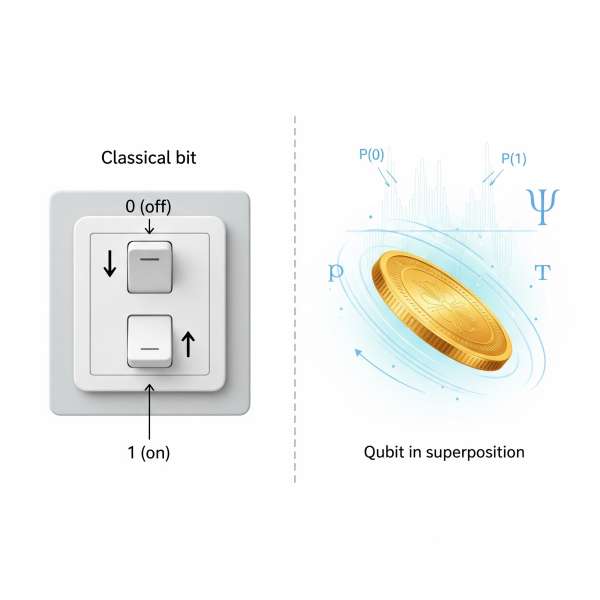
This distinction highlights a key shift. Classical computing operates with discrete values, firmly 0 or 1. Quantum computing, by contrast, works with amplitudes that describe the probability of a qubit collapsing to a 0 or a 1 when measured. While this is a commonly used minimal interpretation in quantum information science, it's important to note that multiple interpretations of quantum mechanics exist, and this probabilistic description is a pragmatic choice to enable computing applications rather than a definitive claim about quantum reality.
Here's one way to think about it: imagine a spinning coin. While it's in the air, it's not just heads or tails, it's both. Only when you catch it (i.e., measure it) does it "collapse" into one of the two. Qubits behave similarly. They hold a range of probabilities until observed.
Now introduce entanglement: when two qubits become deeply correlated in a way that measuring one tells you something about the other. For example, if you measure one, and it collapses to "heads," the other is guaranteed to be "tails." But—and this is crucial—this correlation doesn't transmit information. It's instantaneous but doesn't allow faster-than-light communication, so when you measure one particle, you know the state of the other particle instantly, but you don't have control over that. Einstein famously called it "spooky action at a distance," and he wasn't wrong about the weirdness.
These two effects (that is, superposition and entanglement) don't magically make quantum computers faster at everything. Instead, they allow quantum computers to interfere with probability amplitudes, cancelling out wrong paths and reinforcing right ones in very specific types of problems. More on that shortly.
Figure 2 illustrates the process of computing with qubits.
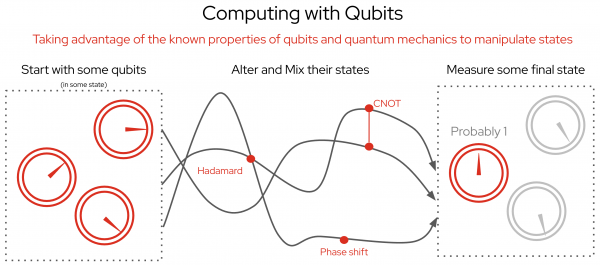
Together, superposition, entanglement, and interference form the foundation of quantum computing and are central to quantum mechanics.
Superposition allows qubits to represent multiple possibilities at once, expanding the space of potential solutions. Similar to a spinning coin that is neither heads nor tails until it lands, a qubit in superposition exists in a combination of both 0 and 1 states until it is measured. See Figure 3.

Entanglement links qubits in ways that have no counterpart in classical computing, enabling strong correlations even across distance. This is the "spooky action at a distance" that Einstein described. When two qubits are entangled, the state of one is instantly correlated with the state of the other, no matter the distance between them. For example, if one is measured as "heads," the other is guaranteed to be "tails." See Figure 4.
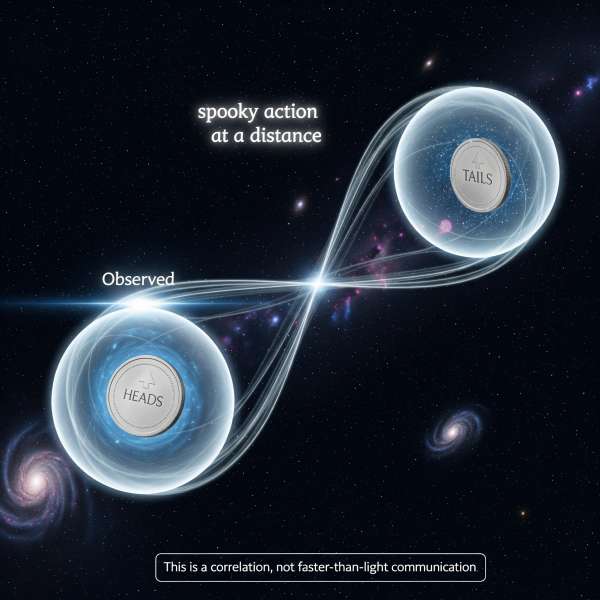
Interference, illustrated in Figures 5 and 6, is the mechanism that allows quantum algorithms to strengthen the right answers and reduce the impact of the wrong ones. This is visualized by the waves in Figure 6, where some combine to create larger waves (constructive interference) and others cancel each other out (destructive interference).
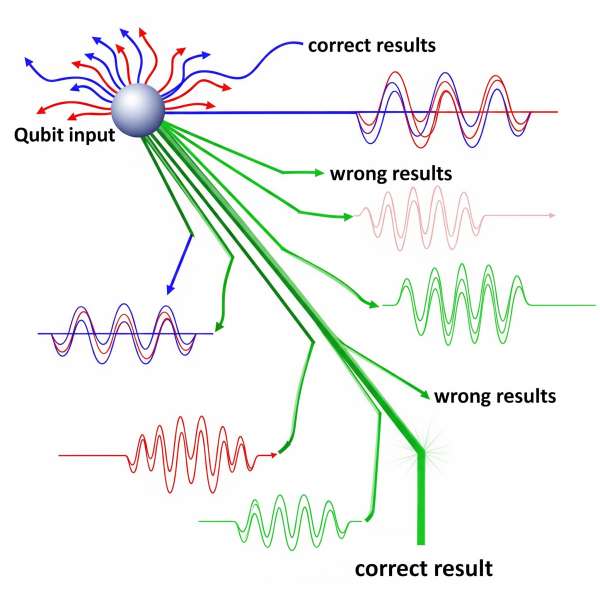

These are not just theoretical ideas. They are the working principles behind a new form of computing (Figure 7). Quantum computing does not simply improve classical methods; it introduces a fundamentally different way of processing information, shaped by the unique laws of quantum physics.
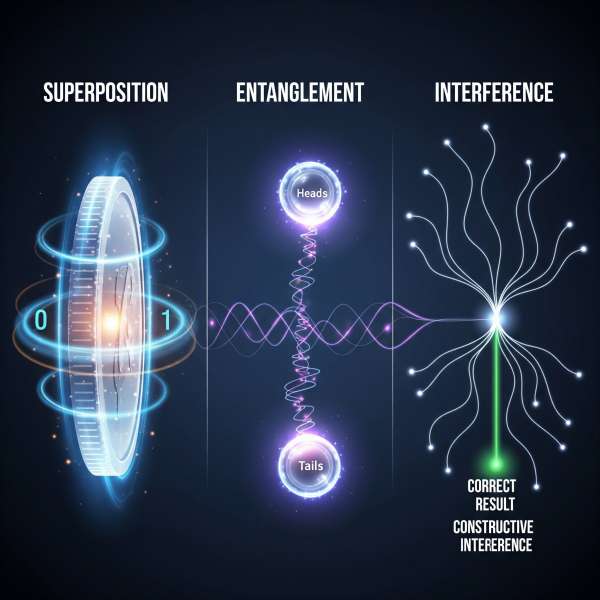
Real qubits
So what does a real qubit look like?
Currently, there's no single dominant technology. Researchers are exploring different approaches:
- Superconducting circuits
- Trapped ions
- Photonic systems, topological qubits, and spin qubits, among others
It is also an area filled with challenges. Every approach has its own tradeoffs in terms of scalability, stability, and error correction. Unlike classical bits, qubits are extremely sensitive to their surroundings. Even tiny environmental changes, such as temperature shifts or background electromagnetic fields, can disrupt a qubit's state. This loss of information is called decoherence and is one of the biggest barriers to building reliable quantum computers.
There is also the issue of noise. Quantum operations are probabilistic, and physical systems are imperfect. This means errors can creep in during calculations. To overcome this, researchers use complex error correction techniques that often require many physical qubits to build one reliable logical qubit.
Another unique challenge is that quantum states cannot be copied. In classical computing, duplicating data is easy. In quantum systems, the no-cloning theorem prevents us from making perfect copies of qubit states. This limitation makes it more difficult to store or transmit quantum information securely and reliably.
These challenges are not just technical details. They directly affect how useful a quantum system can be in practice. For example, a machine with 1000 physical qubits might only have a handful of usable logical qubits if the system is too noisy or the qubits cannot maintain their state long enough to complete a calculation.
Through our relationship with IBM, Red Hat remains closely connected to one of the most advanced efforts in quantum hardware. This collaboration allows us to stay ahead of key developments and confirm that our platforms, such as OpenShift, are well-prepared to support quantum computing as it becomes more accessible through APIs and hybrid deployments.
While commercial quantum computing is still in its early stages, understanding the physical realities of qubits helps us prepare. These systems are complex to build and operate, and integrating them into modern computing environments will take time. That is why Red Hat is focused on creating flexible, open platforms that can evolve with the technology and support it when the time is right to deliver real business value.
Will it replace classical computing?
It's important to understand that quantum computers are not just faster versions of classical machines. They are not supercharged laptops. Instead, they are highly specialized tools built for solving certain kinds of problems that classical computers struggle with, such as complex simulations or large-scale optimizations (see Addendum: Coffee, caffeine, and quantum states).
Think of classical computers as cars. They are great for general tasks like running apps, email, or backend systems. Quantum computers are like airplanes. You don't use them to drive to the grocery store, but they are essential for long-distance travel or highly complex challenges like modeling molecules or cracking hard math problems.
In the future, most systems will be hybrid. Your regular application will handle most tasks as usual. But when it encounters a problem that is too complex, it can call a quantum coprocessor to help solve that specific part, just like GPUs are used today to handle AI workloads.
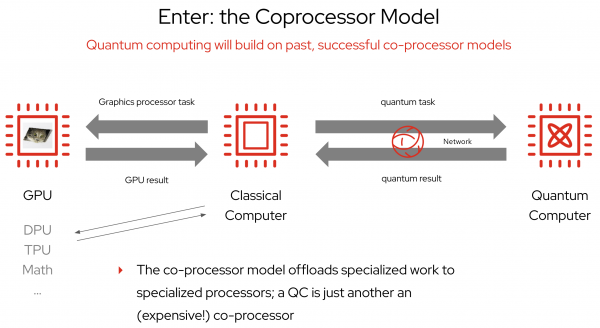
From theory to impact: Where quantum will change the game
You won't use a quantum computer to check your inbox or browse LinkedIn. But for certain industries, the impact could be massive. Here are some early use cases.
Finance
Financial institutions juggle countless variables to optimize portfolios or price derivatives. Quantum computers can evaluate many market scenarios at once, improving risk models and boosting returns. Think smarter retirement planning or faster fraud detection.
Healthcare and pharmaceuticals
Designing a drug is like searching for a molecular needle in a haystack. Quantum computers can simulate how molecules interact (i.e., faster and more accurately), helping create new treatments and personalized medicine based on DNA.
Logistics and manufacturing
Finding the optimal route for thousands of deliveries is a classic hard problem. Quantum algorithms can evaluate millions of routes in parallel. Result: faster delivery times, reduced emissions, and lower costs.
Energy and utilities
Matching power supply with demand, especially with renewables, is unpredictable. Quantum models could optimize energy storage and distribution in real time, making grids more efficient and resilient.
Cybersecurity
Quantum computers will eventually break today's encryption, but they'll also help invent new, quantum-proof cryptography. This is not a future problem: data stolen today could be decrypted tomorrow. Migration to post-quantum security needs to start now, e.g., with post-quantum cryptography since Red Hat Enterprise Linux 10.
Why quantum matters
Quantum is about solving complexity. If your business depends on optimization, data, simulation, or security (and most do), quantum matters.
You don't need to buy a quantum computer. But you do need infrastructure that can prepare for this shift. Red Hat is already enabling this transition: from post-quantum cryptography in RHEL 10 to quantum-ready hybrid cloud architectures.
Why developers should care
Quantum computing will change how we:
- Solve optimization problems (for example, scheduling, logistics, routing)
- Accelerate and train AI models
- Design secure communication protocols
- Make architectural decisions for hybrid workloads
Not by replacing your systems, but by expanding what they can do.
This is where Red Hat's hybrid cloud and open source approach becomes key. It gives you a foundation that can adapt and grow.
The Red Hat connection: Quantum in a hybrid cloud world
So how does quantum computing fit into the world of Kubernetes, open source, and enterprise platforms?
OpenShift and Kubernetes-native workloads
Your future apps won't be "quantum" or "classical." They'll be both. OpenShift provides the control plane to manage classical workloads alongside quantum APIs. Whether the QPU is in the cloud or on-premises, OpenShift can orchestrate it.
Service mesh and APIs
Quantum tasks will be executed through APIs. Red Hat OpenShift Service Mesh can handle the security, observability, and reliability of those calls: just like it does today for microservices.
Developers can keep using familiar tools like Python, Java, Kotlin, etc. The learning curve is surprisingly manageable.
Quantum networking
Quantum networking is still in development, but secure-enhanced protocols like quantum key distribution (QKD) could eventually replace or extend TLS for high-trust environments. This could be a game-changer for sectors like government, healthcare, and defense, and could be embedded in service mesh architectures.
AI development and quantum acceleration
Quantum machine learning (QML) could make AI smarter and faster by solving problems that current methods can't handle well. Red Hat OpenShift AI and Red Hat's ML pipelines could be extended to tap into quantum backends for next-gen model training. Next to that, some research and development (R&D) divisions are trying to train ML models on mimicking quantum systems so you could bring quantum to local machines. But this is still in early R&D phase. In this case, platforms like OpenShift (AI) could bring the power of quantum to your own environments.
Post-quantum security
Quantum can crack today's cryptography. That's a big risk, but it also gives us a reason to upgrade. Red Hat has integrated Post-Quantum Cryptography into Red Hat Enterprise Linux and is looking to adopt these same components for Kubernetes security models to help create future-proof workloads today.
Addendum: Coffee, caffeine, and quantum states
Let's make this concrete with something familiar: a cup of coffee. (If this text is too complex, see Figure 9, which contains extra explanations on the mentioned concepts and numbers).
The stimulating effect of coffee comes from caffeine molecules. At first sight, caffeine looks straightforward: 24 atoms connected in a small structure. But when you look closer at the quantum level, things become much more complex: Each atom in caffeine can vibrate, rotate, and rearrange in different ways. The electrons can also move between energy levels.
When you combine all these quantum possibilities, caffeine has around 10⁴⁸ potential energy states, which is a 1 followed by 48 zeros.
Here's where quantum computing shines. Unlike classical bits, which can only be 0 or 1, qubits can represent many states at once. This property means that while a classical computer would need an impossible amount of storage to model caffeine, a quantum computer would only need about 160 qubits to represent the same state space.
So the caffeine-in-coffee example isn't really about coffee at all: It's a reminder that quantum computers can tackle problems of staggering complexity that classical machines simply can't reach. (And that potential could transform how industries innovate.)
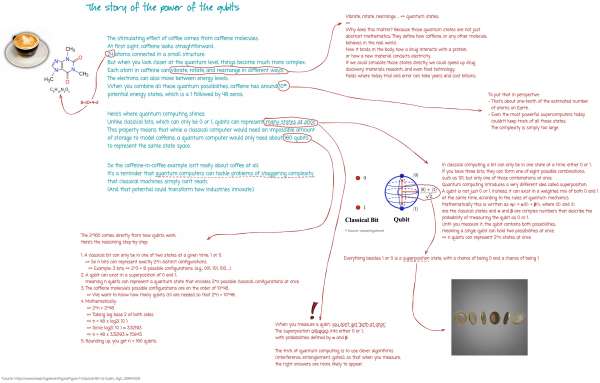
Final thoughts
Quantum computing won't make Kubernetes obsolete or replace AI, but it will become part of the toolbox. Red Hat's strength in building scalable, hybrid systems that incorporate strong security capabilities makes it well positioned to bridge the classical and quantum worlds.
So let's start that journey today, with open minds, open source, and a platform built for what's next.
